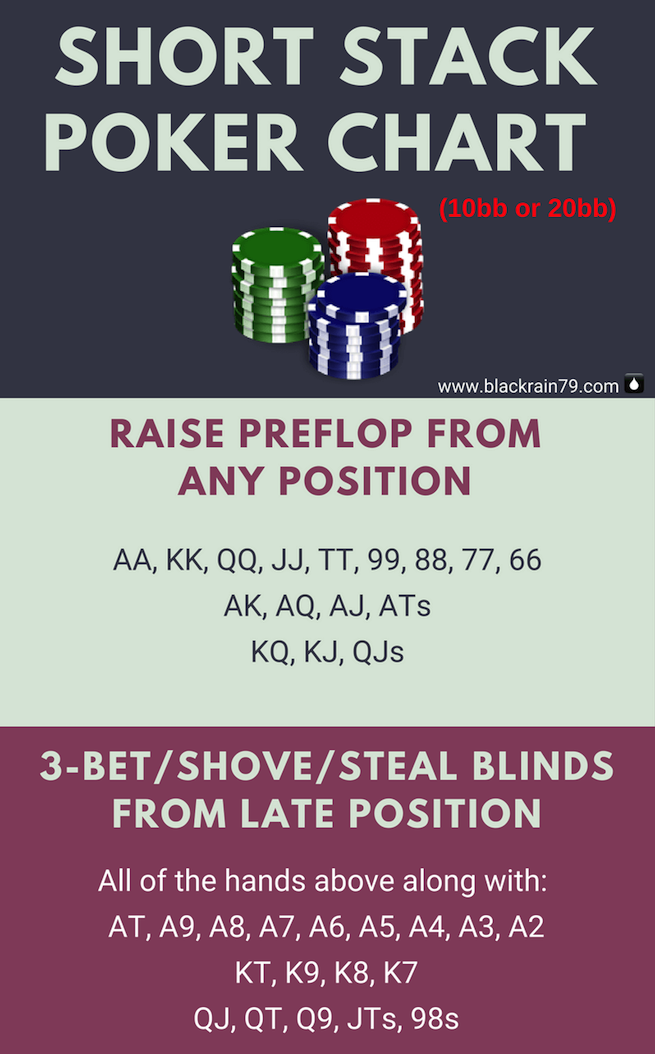Poker Tournament Raising Blinds
_depart.jpg/220px-US_Navy_110929-N-JE719-073_Sailors_participate_in_a_poker_tournament_on_the_mess_decks_sponsored_by_the_Morale%2C_Welfare_and_Recreation_(MWR)_depart.jpg)

Play Short Stack Poker Like a Pro
As tournament players, we constantly find ourselves in situations where we have to play short stack poker. For the purpose of this article, I will define a short stack as 25 big blinds or less when the average player we are up against has considerably more than this. The small stakes poker tournaments I play are often profitable because of mistakes others make when short-stacked — even those who are otherwise decent deep-stacked players.
In a dead blind, the small blind or dealer button may be placed at an empty seat to assure the big blind is properly positioned. If a game has come down to a head-to-head, the dealer will also be the small blind. The players in the small blind and big blind positions are permitted the opportunity to raise once their turn has come back into play. Some poker players prefer to shove on any cards while others raise the blinds no matter the hole card combination. Conservative players elect to fold small blinds and wait for an ace or face card before playing. If an opponent is conservative, a player should consider an aggressive approach as to what cards to play pre-flop. How many times during the first couple levels of a tournament do you see someone raise 10-20 big blinds (BB)? Blinds are 10/20 but someone raises to 250 in middle position with no.
Here are five of the most common blunders we see players make in poker tournaments on the Play WSOP site when short-stacked.
1. Limping in to see flops
“I mean, do you just not like poker? You know it’s more fun if you see a flop every now and then!”
That statement was made to me after I’d shoved my 25-big blind stack over multiple limpers for the third time in a tournament I played at Planet Hollywood during the World Series of Poker this past summer. “You only have one move” was another one I frequently heard from players who did not understand how to adjust to shrinking stack sizes as the blinds increased. These guys wanted to get in cheaply with a speculative hand hoping to hit a flop, and I was the late-position party pooper who constantly ruined it for everybody.
From my point of view, these players would likely have raised rather than limped if they held good hands. This is a concept sometimes referred to as having a “capped range,” meaning that the very best hand they would choose to limp with rather than raise could only be so strong. Now, we’ve all seen guys limp and granted this is a concern from the first limper, but how many times have you seen a third guy limp behind with in a shallow-stacked game? If the first guy is a habitual limper and not particularly trappy, then it is usually safe to assume that everyone limping afterwards does so with capped ranges.
So what can I do with that knowledge when I have a 25-big blind stack? Say we’ve already reached the stage of the tournament when antes have been introduced and I’m in the big blind. A hand comes up with a couple of limpers plus a small blind who completes, meaning when the action gets to me there’s already about 5 big blinds in the pot. A shove here will take down the pot most of the time and add 20% to my stack.
This is a play I make often on the WSOP Social Poker game, including with relatively weak hands like medium-suited gappers or medium off-suit aces. While others are trying to hit flops with these hands, I am the young punk who is denying them that opportunity and winning pots without ever seeing the flop.

2. Not defending the big blind effectively
Poker Tournament Raising Blinds Brackets
Playing a short stack well from the big blind can be a delicate balancing act. You cannot be too tight and you cannot be too loose. I see tons of players making mistakes in this position by leaning too far in either of these two directions. If I have a big stack and I notice a player is too tight from the big blind, I will raise him with a wide range and usually win preflop. If I notice that he is too loose, I also will raise him with a wide range, and usually win postflop when he calls and then folds to my continuation bet.
To prevent me from getting out of line here, the tight player should start to resteal by shoving all-in on me with a wide range. If I open to 2.5x the big blind, then his resteal will net him 5 BBs from the blinds and antes. There’s that 20% increase without ever seeing the flop again. Do that a few more times and you will have gained the same amount of chips as a double-up without having to win a flip.
If I am dealing with the loose player, I will have a slightly stronger range so she can’t resteal on me as widely as the tight player could. What she can do is check-shove me on some flops where I am automatically c-betting. Against a player like this, my c-betting percentage on the flop may be as high as 80-85%, so if she gets a decent piece of it, she should go with her hand against my over-aggressive range.
3. Open shoving for too many chips
Poker Tournament Raising Blinds Replacement Parts
Take care, though, not to be shoving your short stack too liberally. This is a mistake that I have made in the past and sometimes I still revert to it.
Let’s say it folds to me in middle-to-late position and I have 20-25 BBs with a hand like -offsuit or -suited. There might be a temptation to open-shove to keep from having to raise-fold such hands or try to play them postflop against a tricky player in the big blind. This is a mistake because it risks way too much for very little gain. In such a spot an all-in raise that gets everyone to fold would only earn me around 2.5 BBs.
Instead, I should take my chances with more standard raises if I expect the players behind to respond in a way that is profitable, or just fold if I expect those players to give me trouble with effective responses to my raises. Instead of taking marginal open-steal spots vs. good players, it is better to save my chips for restealing.
4. Restealing with no fold equity
If you have not played your 20-25 BB stack well, you will soon find yourself with a 10-15 BB stack once the blinds increase. At this point, even the tightest of players will realize that they are slipping closer to the desperation zone.
I’ve seen guys who were tight the whole tournament get tired of me raising their big blind and finally decide to take a stand and resteal for their last 10 big blinds with a hand like -offsuit. The problem for them, though, is if I have something like -offsuit or even -suited, I can call because with their short stacks I would only need around 35% equity against their range.
“How can you call with that?” is a question I will hear in such situations. But had they made the same move when they had just a few more chips, I could not have called.
5. Blinding off
Poker Tournament Raising Blinds Bracket

This is probably the worst mistake of all to make when short-stacked. If you have not played your 10-15 BB stack well, you will subsequently find yourself with less than 10 big blinds more than your fair share of times when the blinds go up. At this point, your options become very limited. You basically have to pick any decent hand and shove it. If you do not get a decent hand by the time you are down to around 5 big blinds, you may have to shove any two cards whenever there is a very tight player in in the big blind.
I remember a friend once telling me how he had folded -offsuit from middle position when he had 8 big blinds. Later when the blinds increased, he finally picked up and shoved his last 3 big blinds into a guy who called without even looking at his cards. He lost to and could not believe how badly he had run.
Poker Tournament Raising Blinds Near Me
The truth of the matter is even if he’d won the hand, he still would have been in bad shape unless he’d found another premium hand very soon. Don’t be that guy.
Home Poker Tourney Blind Structure
Conclusion
At some point, almost every poker tournament becomes shallow, even those great free tournaments on the WSOP Social Poker app. If you want to improve your play, you must learn how to play a short stack well. If you are primarily a cash game player who wants to play a tournament but you don’t have much experience with short stacks, you might occasionally play some sit-n-gos to work on these skills. In my opinion, short-stacked play is the most important aspect of tournament poker.
This article was originally published on September 14, 2014. Last update: July 22, 2019.
Tags
tournament strategyno-limit hold'em